Recipe for Homemade Chicken Broth
If you aren’t making your own chicken broth, you’re missing out. This recipe for homemade chicken broth is an easy and detailed one for making tasty and healthy chicken broth right at home. Keep reading for all the details.
Chicken Stock vs Chicken Broth
If you’re wondering what the difference between chicken stock and chicken broth is, here it is. The biggest difference is that chicken stock is made with bones and chicken broth with meat. With that said, meat can be added when cooking stock in order to give it a richer flavor and color. Additionally, stock is usually not seasoned as it is generally used in other dishes like gravies, sauces, stews, etc. Chicken broth, on the other hand, is seasoned as it is generally used for soups.
Side Note: I found this great page on Stock vs Broth which has lots of detailed information on both and covers the differences very well. You’ll probably learn a lot more about stock and broth than you ever wanted to know. It’s very thorough so I hope you check it out.

Please note that some of the links on this page might be affiliate links. View my Privacy Policy for details.
Ingredients for Homemade Chicken Broth
Whole soup chicken – For the chicken broth, I always buy organic chicken. The broth gets used in different recipes and we eat it plain in chicken soup, so it is important for me that it be as healthy as possible.
Onion – peeled, either whole or cut in half.
Carrot – peeled. If the carrot is big, cut in half (fits better in the pot).
Celery root – can also use celery stalks if you don’t have celery root. Celery is optional. So if you don’t have it, just omit it.
Bay leaf – adds flavor to the broth.
Black pepper corns – adds flavor to the broth.
Salt – salt is optional, but I do like to add it because I mostly use the broth for making soup with plain noodles. You can leave off the salt and add it in when you make the final dish which will make it easier to control the salt levels.
Water – you need water to make the broth:) duh!
Homemade Chicken Broth Recipe
Cleaning Raw Chicken
Although the chicken is packaged clean, often there are still some left over hairs or feather ends left on it. I try to remove as much of those as possible. I use a blow torch that stands on its own (something like this) and guide the chicken into the flame to get rid of any extra hairs. I rip out the extra feather ends that might have still been left in the chicken as I don’t want any of that to end up in the broth. I also rinse the chicken thoroughly.
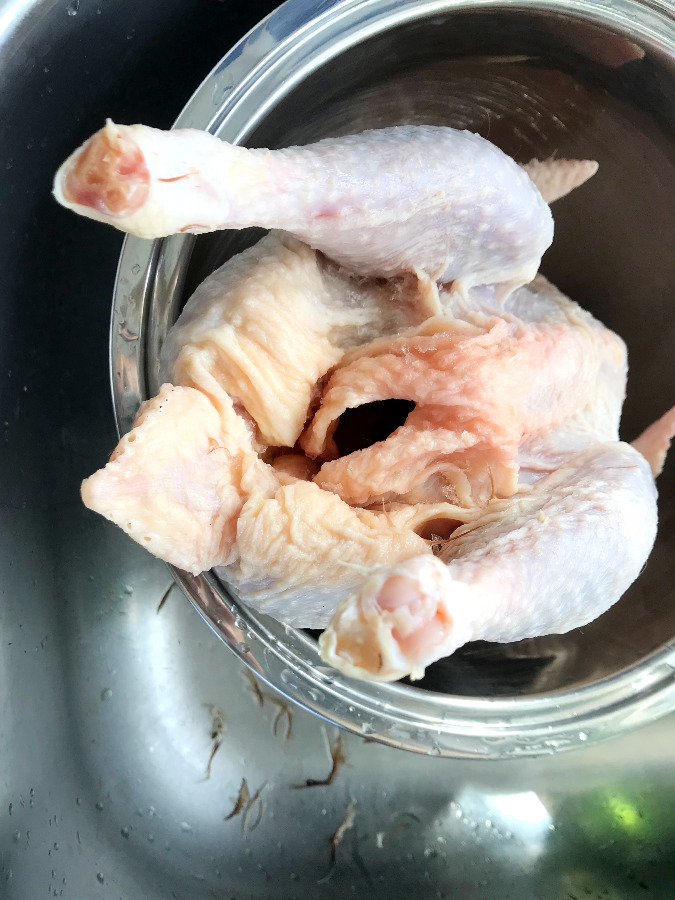
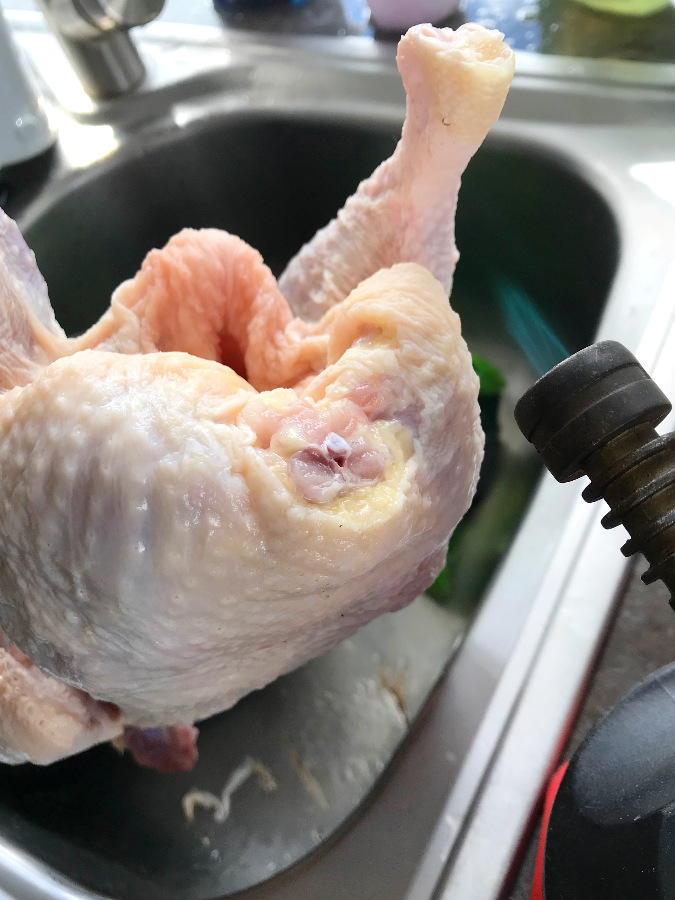
Cooking Chicken Broth
Add chicken to a big stock pot and fill with water. My stockpot fits about 6 1/2 quarts of water (7.5L) and I fill it as full as possible. You can add more or less water, depending on how you want your end result to be. Adding more water will give you more broth, but with less fat. Using less water, will give you a broth that is more fat and has a more condensed flavor. The organic chicken I use produces quite a good broth with enough fat that I would use more water to make more broth but, alas, my pot doesn’t hold more.
Bring the water to a simmer (this can take some time as the pot of water is so big).
Skimming Bone “Scum”
Once the water is simmering, you will see a grayish, whitish foam forming on the top. This is called “scum”. Use a small sieve or ladle to remove this scum until it’s mostly gone (It’s hard to get it all). Note you will need to do this for several minutes as new foam will keep forming and creeping up. If you miss this stage (happened to me before), the soup will start boiling and the scum will just get incorporated into the broth. It doesn’t affect the taste of the broth, but the broth won’t be as clear in the end.
Side note: If you’re interested in more information on the broth scum, take a look at this page from Mio’s Bio Farm. I found it to be interesting.


Once the broth is mostly clean of the scum, add the onion, carrot, celery root, pepper corns and salt. Keep in mind that once the chicken is boiling it will produce the normal “boiling water foam” so don’t confuse it with the scum above. To test, just reduce the heat a bit and see if the foam subsides.
Cover the pot with a lid, reduce the heat to medium-low (make sure it’s still simmering) and let the chicken cook for 4 hours.
Note: Since a whole chicken is being cooked here, it really needs the four hours. If you chop your chicken into smaller pieces, it will not need as much time for cooking.
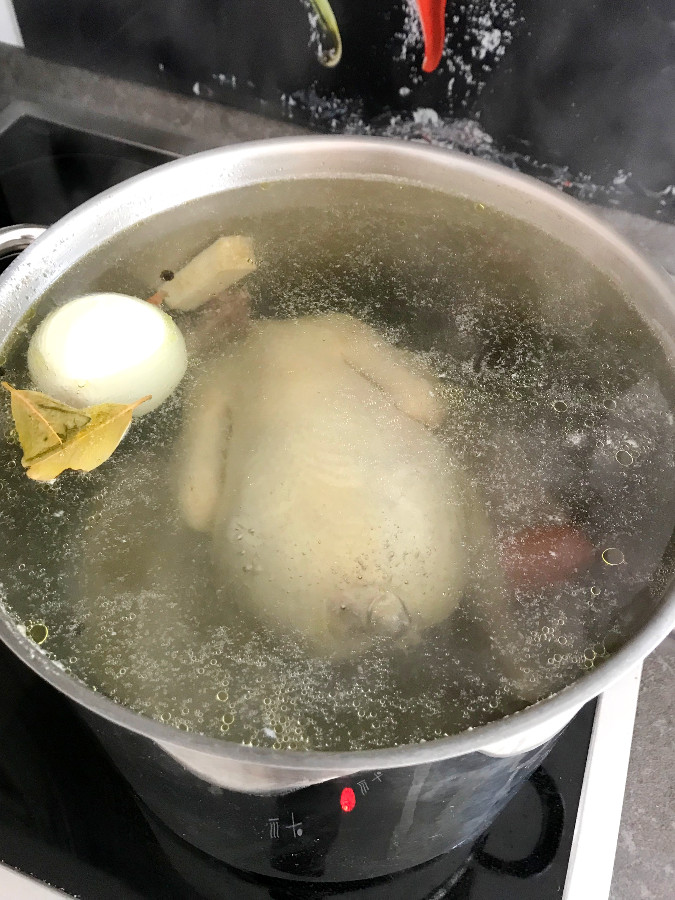
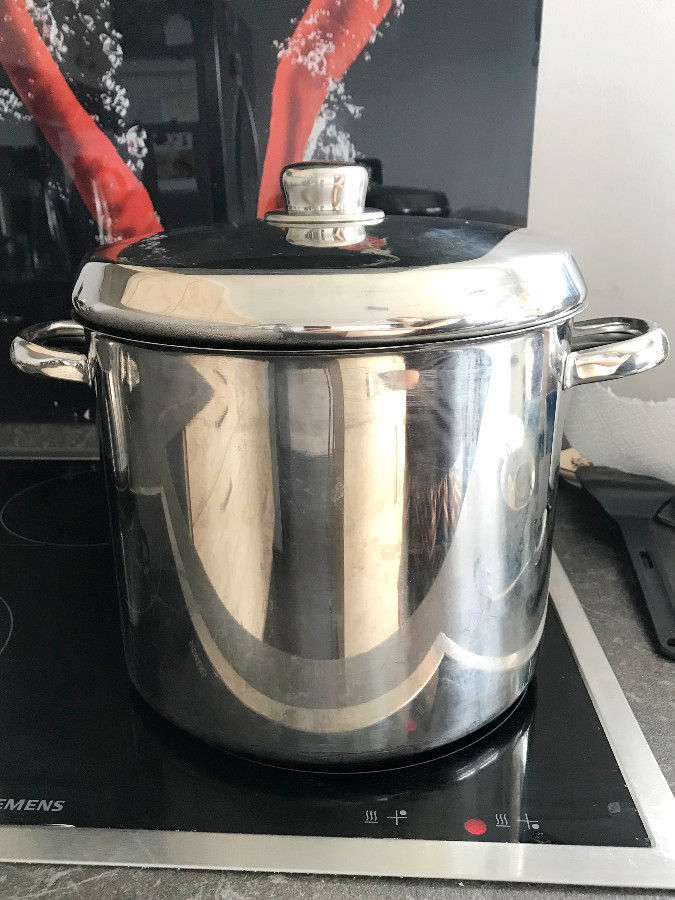
Once the chicken is cooked, take out the whole chicken using kitchen tongs (I have ones like these) and let it cool a bit in a bowl.
After that I ALWAYS (seriously, this is like the whole reason I make broth. lol) make a Simple Egg Noodle Soup with the broth, some thin short noodles and the chicken meat.
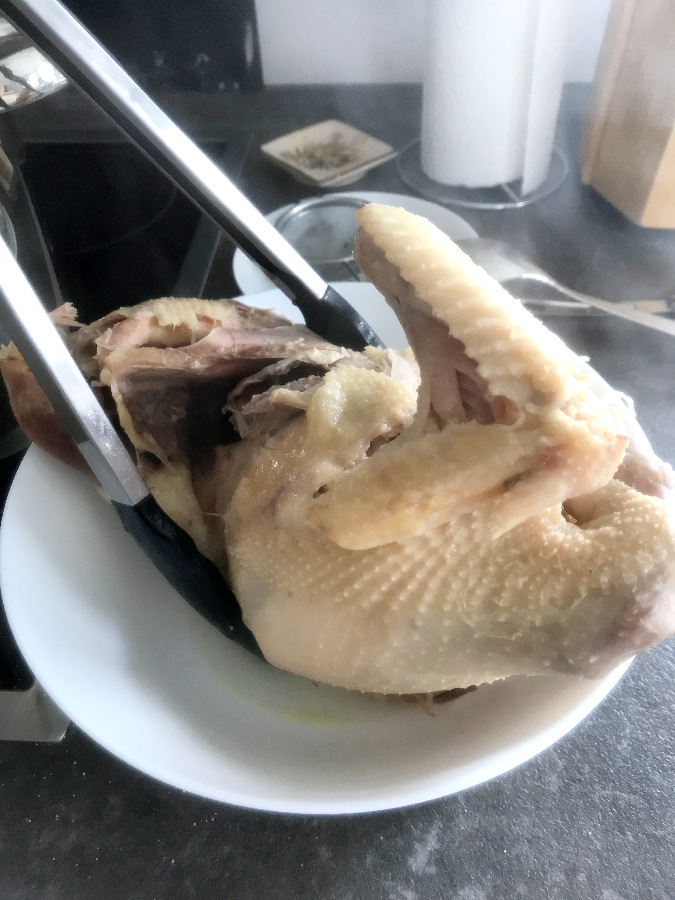
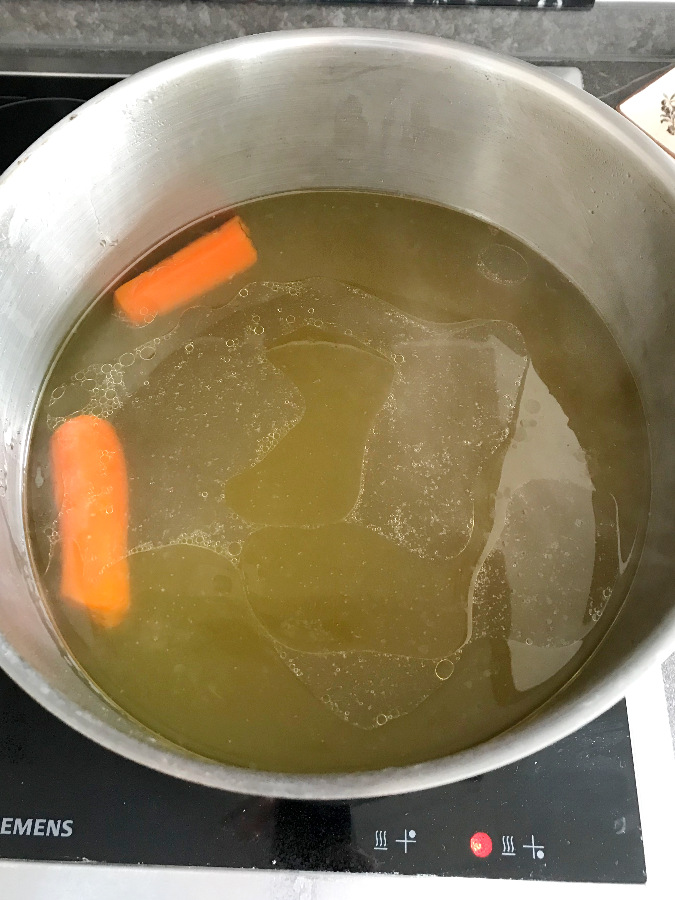
How to Store Chicken Broth
Freeze Chicken Broth
This is the method I use most. Pick off the chicken meat from the bones and place in jars for freezing. Strain the broth into these same jars, making sure to leave 1-2 inches of room at the top. Cover, refrigerate the jars of broth overnight and then freeze them for up to 6 months. We usually use up our whole supply within 2 months of making it.



What to use for Freezing Broth
Glass Jars – I use big store-bought pickle jars and little jam jars to freeze the broth. The big jars get used for soup as I generally need more broth at a time for making soup for my family. The little jars mostly get used for makings sauces and gravies. If I was looking to invest some money into this, I would get these awesome Glass Containers for freezing. However, my store-bought jars work perfectly. This just goes to show that making and storing your own broth doesn’t have to be expensive.
Plastic Containers – If I wasn’t using glass, then I would probably get myself these freezer safe Ziploc Twist ‘N’ Loc Containers
Refrigerate Chicken Broth
Strain broth into jars and refrigerate for. Use up within 3-4 days. You can also just keep in the same pot you cooked it in (if it fits), if you decide to make a big batch of soup or something. The downside of this method is that the broth doesn’t last very long. So it almost makes no sense to cook so much broth at once if you don’t plan to freeze it.
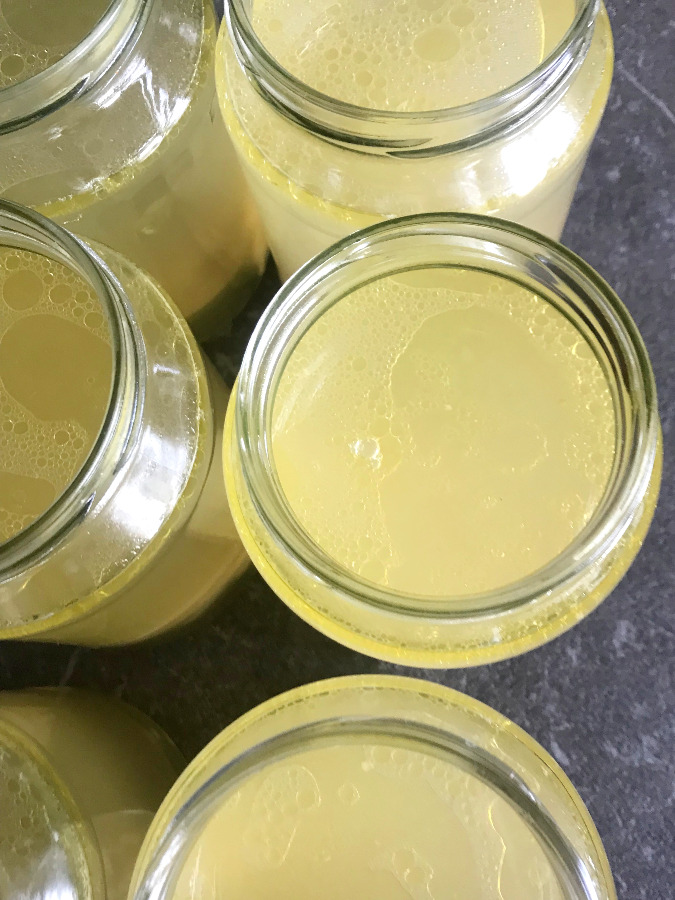
Tips for Freezing Chicken Broth
- Make sure you leave room at the top of the containers. The broth will expand when you freeze it so the extra room is crucial. Especially with glass jars you need the extra room, otherwise they can crack.
- Refrigerate the broth overnight or at least several hours. The broth has to be cold when you place it in the freezer, otherwise it could explode.
- When using the broth, take it out and thaw in the fridge overnight. If pressed for time, place the jar of frozen broth into a bowl and pour cold/warm water in the bowl. Let it thaw on the counter.
How to use frozen chicken broth
Soups – our absolute favorite way to use the broth is to make this Egg Noodle Soup with Chicken. Seriously, this is like our sole reason for making the broth:))
Additional favorite recipes for using chicken broth:
Grains – Use it in place of water in cooking grains for a more flavorful side dish:

Lastly, if you make this Recipe for Homemade Chicken Broth, make sure to leave a comment and/or give this recipe a rating here! I’d love to hear back from you and will do my best to answer and respond to every comment. And of course, don’t forget to tag me on Instagram if you make this recipe. I’d love to see the photos of the recipes you have made!
Recipe for Homemade Chicken Broth
Ingredients
- 1 Whole soup chicken (1.2kg) (preferably organic)
- 6.5 Qt (7 ltr) Water
- 1 Medium onion
- 1 Medium carrot
- 1-2 Bay leaves
- Piece of celery root (about an inch long)
- 2 tbsp Salt
- 1 tsp Black pepper corns
Instructions
- Wash and clean the chicken. Use a blow torch to get rid of any little hairs and pluck out the feather ends.
- Add chicken to a big pot and fill it with water. Bring it to a simmer.
- Once the water starts simmering and forming "scum", use a small sieve to pick off the scum. Keep skimming the scum off the broth until no new scum forms.
- Add the carrot, onion, celery root, pepper corns and salt to the pot. Cover the pot with a lid and simmer on medium-low heat for 4 hours. Make sure the water is simmering, but is not boiling. Adjust the heat as necessary.
- Remove chicken from pot. Chicken can be eaten, used further in a different recipe, or picked from the bones and frozen along with the broth.
- Strain the broth into glass jars using a small sieves making sure to leave 1-2 inches of space at the top. Refrigerate overnight and then freeze.
- To use frozen broth, remove from the freezer and let thaw in the fridge overnight. If you are pressed for time, place the broth into a bowl and fill the bowl with water. It will thaw faster.


One Comment